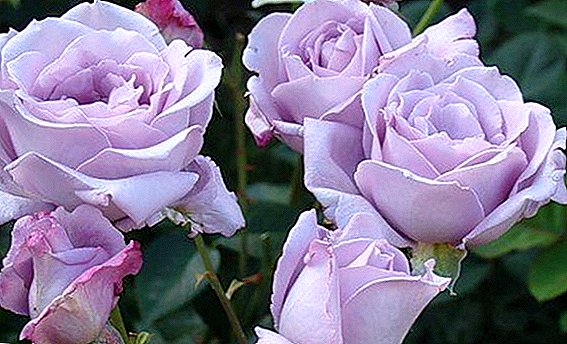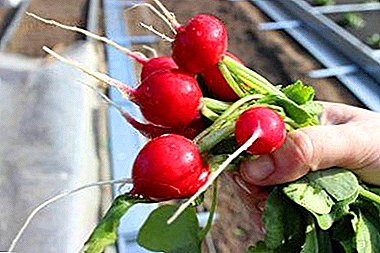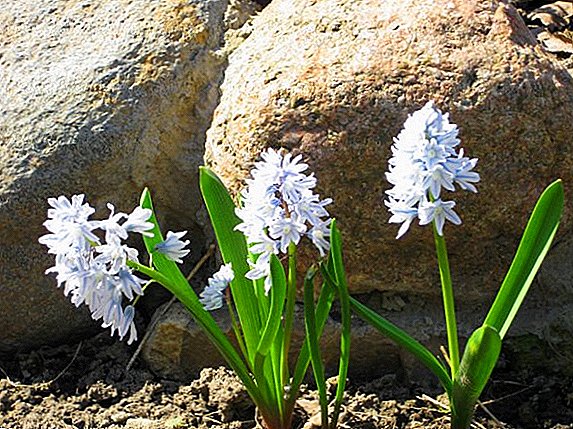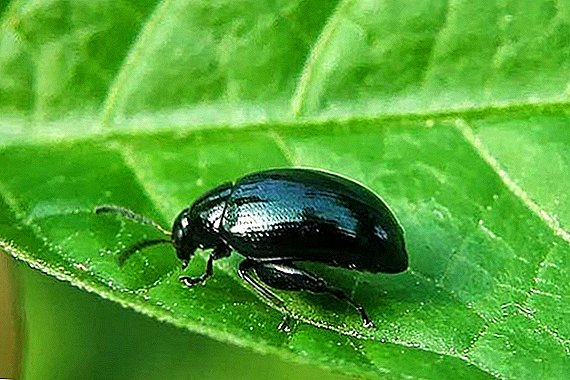 Cruciferous flea has absolutely nothing to do with the family of Fleas. These are small, black and blue, very mobile insects with a jumping back pair of legs. If they are disturbed or frightened, they jump like grasshoppers.
Cruciferous flea has absolutely nothing to do with the family of Fleas. These are small, black and blue, very mobile insects with a jumping back pair of legs. If they are disturbed or frightened, they jump like grasshoppers.
What does a flea look like?
The cruciferous flea family is quite extensive, with many varieties. The bugs look different, there are insects with blue, green and black color of the chitinous shell, some have a sand-colored strip on the black wings.
Cruciferous flea beetles not only have a different color, but also different sizes. The smallest sizes reach 1.8 mm, and the largest grow to 3 ml.
Lives pest throughout the former Soviet Union, with the exception of the Far North. The vital activity of this insect causes great damage to cruciferous crops.
The female cruciferous flea lays its eggs in the recesses or holes that are gnawed on the roots of the plants or on the surface of the ground. Hatching larvae hiding in the ground and a couple of weeks (while growing up), eat young plant roots or peel of root crops.  Where they feed, the larvae pupate, and after another 10 days young bugs appear. During the summer period 2-3 generations of flea pods can hatch.
Where they feed, the larvae pupate, and after another 10 days young bugs appear. During the summer period 2-3 generations of flea pods can hatch.
Harm caused
Adults prefer to winter in the ground of fields where they lived and multiplied in summer, or in the plant remains of cruciferous crops.
In the spring (April - beginning of May), as soon as the soil warms up, the insects come out of hibernation. Before the first shoots of crops, bugs eat wild cruciferous plants (shepherd's bag and colza).
After the first sprouts of seeded cruciferous (rapeseed, radish, cabbage) hatch, they migrate to the fields and vegetable gardens.
Eating young leaves, cruciferous flea gnaws through holes through them. If you tighten with the beginning of the fight against the pest, the beetles can eat or damage the very point of growth of the plant, it will die.
But simply gnawed, sometimes to the skeletal base of leaves, the plants are oppressed, their growth slows down or stops.
The pest loves to eat all cruciferous plants. This group includes: all types of cabbage, radishes, mustard, daikon, turnips, spinach, horseradish, radish and turnips. They like fleas and flowers, with pleasure they eat Mattiola, Levkoy. But the cruciferous flea on rapeseed brings the most damage.
Rapeseed is sown on an industrial scale, occupying vast areas, since this crop is the raw material not only for the production of edible vegetable oil, but also the basis for biofuels, cosmetics, detergents and various technical oils.
Did you know? The greatest activity of insects - the first half of the day and early evening. In the afternoon, in the heat of the beetles inactive.
Signs of appearance on the site
If the garden plot or field is populated with cruciferous flea, no need to do analyzes and samples - it is easy to see visually. For example, when inspecting rapeseed crops, damaged leaves are visible, the cruciferous flea gnaws through the leaves.  Sensing the approach of a person, the pests start jumping in different directions, and this is hard not to notice.
Sensing the approach of a person, the pests start jumping in different directions, and this is hard not to notice.
Methods of struggle
It is most effective to begin the fight with cruciferous fleas in the period when the crops only emit seed-leaves. It is during this period that the plants are most vulnerable to the pest and can be destroyed by them completely (by eating the growth point of the plant).
There are three options for dealing with insects:
- biological agents;
- chemicals;
- preventing the occurrence of pests.
Folk methods
It is not always necessary in the fight against pest to go to extreme measures and use chemicals, you can try to cope with traditional methods.  Here are some of them:
Here are some of them:
- Flea does not like wet soils. To expel the pest you need to water the plants well.
- Pollinating cruciferous on the leaf with dry ash or a mixture of ash and crushed tobacco dust.
- Pollination between rows (on the ground) with mothballs or tobacco dust.
- Spraying of crops with herbal decoctions and infusions.
- Add 1 parts of boiling water to 1 part of wood ash. Insist 48 hours. Add liquid soap before use.
- Grind a glass of tomato leaves and a glass of garlic. Add 10 liters of water and 1 tablespoon of liquid soap. The infusion is ready.
- Roll in a meat grinder or blender 0.5 kg of dandelion roots and leaves. Add milled mixture and a little soap to stick to a bucket of water. Before use, strain the solution through gauze.
- A glass of tobacco crumbs pour 10 liters of hot water, add 1 tablespoon of liquid or household (rubbed) soap.
- Pour a glass of vinegar (9%) or 2 tablespoons of vinegar essence into a bucket of cold water. The solution should be used immediately after preparation.

Important! Beds of rapeseed, cabbage or radish are planted with plants that produce volatile production. Leaf beetles avoid such a neighborhood and prefer to move to a more peaceful place. These fragrant aggressors include nasturtium, marigold, dill, garlic, onion, calendula, tomatoes and potatoes.
Sticky trap
Such a trap is made of a sheet of paper, plywood or fabric (the matter is fixed on a stick, like an improvised flag). The surface of the paper (fabrics, plywood) is covered with a sticky substance (grease, resin) and pass along the beds with cruciferous culture.
At the same time, the trap is carried low over the bed, almost touching the plants. Bugs, frightened by the presence of a person and a foreign object, jump in a panic and stick to a sticky trap.
Several outputs of the flea hunter to the beds, and the number of pests is reduced several times. It is best of all to carry out such procedure in the evening, after 18 hours.
Trap from car service
Car owners will always find in the garage the development of motor oil. Pieces of cloth (rags) soaked in such a technical workout, laid out on the track in the affected flea beds.
It is possible to place fabric traps in the rows between crops. For greater efficiency, such traps need to be turned over once or twice a day. 
Chemicals
Preseeding treatment of seeds can prevent damage to young crops of the cruciferous flea. Insecticides and disinfectants protect plants well.
If the sowing grain (seeds) were not previously processed, it is necessary to carry out such processing on the first shoots.
This is how crops of rapeseed and other cruciferous crops are processed, without having to wait for full germination, as the majority of the pests are on the ground surface, waiting for the emergence of the crop.
The maximum pest infestation threshold is 1–3 fleas per square meter.
To destroy the cruciferous flea use insecticides:
- Alfa-Tzipi (Ivanhoe, Accord, Alterr, Alfas, Alfatsin, Alfashans);
- "Danadim Expert" ("Di-68", "Pochin", "Rogor-S");
- Tod, Taboo (Akiba, Nuprid 600, Pikus);
- Karate Zeon (Altyn, Break, Gladiator);
- Alatar, Tabazol (Antitlin, Tobacco Dust);
- Kaiser (Kruiser);
- "Zolon", "Pirinex Super", "Shaman";
- "Arrivo" ("Volley", "Fitozan");
- Sumi Alpha.
 In garden centers, growers can get advice and detailed advice on the selection of insecticides. Spraying on the sheet should be carried out in the evening, as at high daytime temperatures the preparations partially lose their effectiveness. Yes, and flea evening sitting on the leaves of plants.
In garden centers, growers can get advice and detailed advice on the selection of insecticides. Spraying on the sheet should be carried out in the evening, as at high daytime temperatures the preparations partially lose their effectiveness. Yes, and flea evening sitting on the leaves of plants.Did you know? Biologists classify cruciferous flea beetles as representatives of the subfamily of Kozyavkov from the family of beetle leaf beetles.
Before mass application of insecticide on a large area, you need to pre-process several plants. If the applied drug is not damaged by plants, then other crops are sprayed with toxic chemicals.
In case several step-by-step treatments from a cross-shaped flea are needed, it is recommended to alternate different preparations.
When using chemically active drugs, you must carefully follow the instructions attached to the insecticide. In no case do not exceed the percentage ratio of the substance and water specified in the instructions.  If it rains soon after the spraying, the procedure is repeated. Time sufficient to destroy the bugs - 10 hours.
If it rains soon after the spraying, the procedure is repeated. Time sufficient to destroy the bugs - 10 hours.
Important! We must not forget that in carrying out chemical treatment of plants, it is necessary to use protective equipment for a person (mask, gloves, outerwear, headgear).
Preventive measures
Instead of exhausting struggle throughout the summer with bugs, you can take measures to pre-empt them:
- If you spend under winter plowing or digging the soil, then the pests that have settled in it for the wintering will die when the frost comes.
- As soon as the snow melts, it is necessary to remove from the garden vegetable residues of cabbage, root-cherries of radish, rapeseed stalks and so on. Everything collected is best burned. The insects that have emerged from the land, having not found food, will leave these beds, migrating in search of more accessible fodder.
- Planted plants mulch between the rows of cut grass. Where there is no open ground, cruciferous fleas almost do not appear.
- A good deterrent effect is also spread out near the crops or plantings of the cruciferous sprigs of tansy, tomato stems (cut when grazing tomatoes).
- Young plants feed up several times at the beginning of the growing season. If the plant is strong, high, the leaf is more coarse, respectively, it is less attacked by insects. Fleas like weak or young plants.

If the bed with cruciferous crops is not very large, it is possible to cover it with agrofibre in early spring and not to process it additionally. Agrofibre does not prevent the access of light and water, but is an insurmountable barrier to pests.
If the plant breeder wants to keep his fields intact, he will have to start the fight with cruciferous fleas in early spring and continue to closely monitor crops until the end of summer. A bountiful harvest will be his reward for work.












